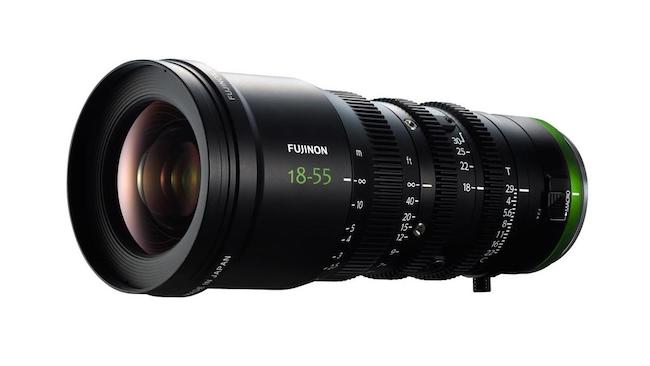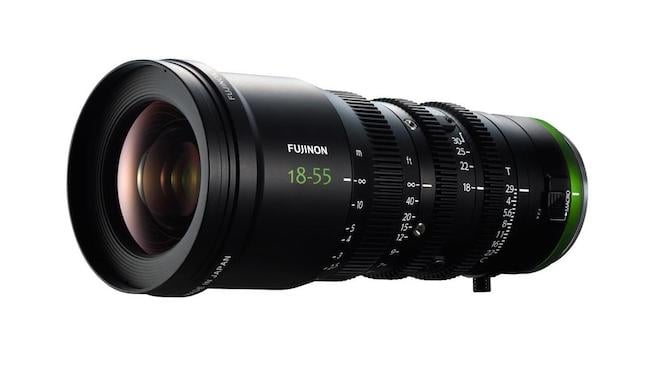
 The new Fujinon MK18-55mm T2.9: A lot of glass for $3799
The new Fujinon MK18-55mm T2.9: A lot of glass for $3799
Fujifilm says that its new MK series of cinema lenses boast advanced optical performance, coupled with ultra-compact and lightweight design and excellent cost performance. At $3799 for the initial Fujinon MK18-55mm T2.9 it could have a point.
The company is targeting the 18mm to 135mm sweet spot first; the $3799 Fujinon MK18-55mm T2.9 standard zoom rolling out in early March, to be followed by the as yet unpriced (and still in develooment) Fujinon MK50-135mm T2.9 telephoto zoom in the summer. Both will initially be available as E mount lenses, with X mount versions expected by the end of the year
As the company is swift to point out, cinema lenses are a popular choice to achieve a shallow depth-of-field and a beautiful bokeh, but are somewhat handicapped by being typically large, heavy and expensive.
The MK series, however, achieve their optical performance by incorporating the benefits of short flange focal distance (defined as the distance from the lens mounting reference plane to the sensor) into optical design to the maximum extent. “The use of optical and mechanical design optimized for dedicated movie lenses minimizes focal shift and optical axis shift while zooming, and lens breathing that are typically observed in interchangeable lenses for digital cameras, “ says the ocmpany.
The lenses feature three rings to enable manual and independent adjustment of focus, zoom and iris (aperture), all with the gear pitch of 0.8M (module). The focus ring can rotate fully up to 200 degrees to help with precision focusing.
Fujinon has also ensured a standardized design across the series for ease of use: only one matte box between the lenses is needed with an 85mm front diameter; only one filter size between the lenses is needed with a filter thread of 82mm; and the gears for the three rings are positioned in the same place so users don’t need to reposition accessories when switching lenses.
What's more, we have some footage as well. The video below features footage shot by Philip Bloom in Gran Canaria using a MK18-55mm T2.9 lens and Sony FS7, FS5 and A7S II. And below that there is the by now traditional behind the scenes video of the video too. A press release with all the details in it is over the page.
Fujifilm launches the “MK lens” series of innovative cinema lenses
Delivering advanced optical performance, ultra-compact and lightweight design and excellent value for money to cater for the growing demand for powerful equipment for movie production by emerging cinematographers
February 22, 2017
FUJIFILM Corporation (President: Kenji Sukeno) has unveiled the MK series of new cinema lenses, which boast advanced optical performance, ultra-compact and lightweight design and excellent cost performance. The FUJINON MK18-55mm T2.9 (MK18-55mm), a standard zoom lens with the focal length of 18-55mm is the first MK lens to be released in early March 2017. In the summer, this will be followed by the launch of the FUJINON MK50-135mm T2.9 (MK50-135mm), a telephoto zoom lens offering the focal length of 50-135mm, thus together covering the most frequently-used range of focal lengths from 18mm to 135mm.
The rapid growth in popularity of movies made by emerging cinematographers in recent years including corporate and commercial movies on the Internet and other venues has increased the opportunities of shooting movies using cinema and regular digital cameras, and it boosts demand for high-performance cinema lenses that deliver high resolution and advanced scene-depicting capability. Cinema lenses are the optimal choice to achieve a shallow depth-of-field and a beautiful bokeh. However, since they are typically large, heavy and expensive, those involved in online and other lower cost movie production often opt for interchangeable lenses for digital cameras, which are more affordable and mobile. The problem is that interchangeable lenses for digital cameras are designed primarily for shooting still images, and therefore prone to focus shift and optical axis shift while zooming, and so on. In response, Fujifilm has been working on developing new cinema lenses that offer advanced optical performance with compact size and operability to meet the needs of creative emerging cinematographers.
The MK lenses joining our cinema lens lineup inherit the FUJINON cine lenses’ advanced edge-to-edge optical performance and low distortion*1, and yet boast compact and lightweight design as well as the level of outstanding cost performance that has never been seen in conventional cinema lenses until now.
The MK series offers fast lenses with T2.9*2 speed across the entire zoom range, enabling a shallow depth-of-field as well as a beautiful bokeh effect. The lenses will be compatible with E-mount*3 cameras with the Super 35mm*4 / APS-C sensor and the X Mount used in Fujifilm’s “X Series” of digital cameras (APS-C sensor). They achieve advanced optical performance despite their compact and lightweight body by incorporating the benefits of short flange focal distance*5 into optical design to the maximum extent. The use of optical and mechanical design optimized for dedicated movie lenses minimizes focal shift and optical axis shift while zooming, and lens breathing (change of angle of view during focusing) that are typically observed in interchangeable lenses for digital cameras. The lenses feature three rings to enable manual and independent adjustment of focus, zoom and iris (aperture), all with the gear pitch*6 of 0.8M (module). The focus ring can rotate fully up to 200 degrees to facilitate precise focusing. This design makes the lenses comfortable to operate.
Fujifilm will firstly release the MK18-55mm (focal length of 18-55mm) for the E Mount in early March, followed by the MK50-135mm (focal length of 50-135mm), also in the E-mount this summer. Their X Mount versions (focal lengths of 18-55mm and 50-135mm) are being developed for launch by the end of 2017.
[Under development] MK50-135mm
(E-mount)
MK18-55mm (E-mount)
FUJINON lenses offered by Fujifilm have been used at movie / CM / TV production sites around the world for their advanced scene-depicting capability. Tapping into its optical, high-precision processing and assembly technologies that have been nurtured over the years in the cutting-edge field of movie production, Fujifilm will introduce the “MK lens” series to the current lineup of the “HK / ZK / XK lenses” to meet the diverse needs at the movie production frontlines.
*1 ”Distortion” refers to a phenomenon in which an image formed through a lens becomes partially contracted or extended at the edges.
*2 T-stop value is an index that indicates brightness of a lens based on its F-stop value and transmission rate. The smaller the value, the greater amount of light the lens transmits.
*3 Lens mount format developed by SONY Corporation
*4 Super 35mm is a standard format for motion film cameras using 35mm film stock, and refers to a sensor size used in many cinema cameras.
*5 Distance from lens mounting reference plane to sensor
*6 Distance between gear teeth
1. Product name and release date
“MK lens” series of cinema camera lenses
(1)FUJINON MK18‐55mm T2.9
Release date: Early March 2017
(2) FUJINON MK50-135mm T2.9 (under development)
Release date: Summer 2017
Information about MK lenses in the X Mount will be provided as soon as more details are confirmed.
See our latest lens roadmap for the X Series on February 22 for more information.
http://www.fujifilm.com/products/digital_cameras/xf_lens/roadmap/index.html
2. Main features of the MK lens series
(1) Advanced optical performance, packed into the compact and lightweight lens barrel
・ The MK lenses offer advanced edge-to-edge optical performance and low distortion. They are designed with integrated color temperature with other FUJINON CINE lenses in the HK / ZK / XK series to simplify color grading*7 that is required when using a combination of multiple lenses.
・ They have T2.9 speed across the entire zoom range which facilitates the increasingly popular style of bokeh effect with shallow depth-of-field. This also eliminates the need to re-adjust lighting, thereby contributing to shortening shooting time.
・ The MK series will be specifically designed for E-mount cameras with Super 35mm / APS-C sensor, and X Mount (for APS-C sensor) used in Fujifilm’s X Series of mirrorless digital cameras. They achieve advanced optical performance despite their compact and lightweight body by incorporating the benefits of short flange focal distance into optical design to the maximum extent. This accommodates shooting with a limited number of people.
(MK18-55mm and MK50-135mm are for the E-mount only and weigh approx. 980g.)
*7 Processes of correcting colors during movie editing
(2) Resolving issues associated with using interchangeable lenses for still digital cameras in movie production
・The front focusing group of lens elements and the zooming group of lens elements are driven independently from one another to suppress focus shift while zooming which eliminates the need to re-focus after zooming in or out. The optical and mechanical approach means there is no time lag as seen in an electrical control system.
・The use of the front inner-focusing system controls lens breathing (change of angle of view during focusing), so as to achieve smooth focusing in a impressive scene.
・Manufacturing technology developed for conventional FUJINON cine lenses is applied to control optical axis shift while zooming, ensuring to achieve intended composition every time.
(3) Comfortable operability provided through dedicated movie lenses
・The focus ring features a rotation of a full 200 degrees to facilitate precise focusing even when shooting with a shallow depth-of-field where a high degree of precision is required.
・The lenses feature three fully manual rings to enable independent adjustment of focus, zoom and iris. . This enables intuitive operations which cannot be attained with an electrical mechanism that typically causes time lags.
・All the operation rings have a gear pitch of 0.8M, the same as all other FUJINON cine lenses, which allows the use of all standard third party accessories for movie production, e.g. Follow Focus that enable accurate and smooth focusing.
・The iris supports seamless adjustment that is free of clicking. This enables precise exposure adjustment while also preventing camera shake from clicking as well as the clicking noise.
(4)Standardized design across the series for ease of operation
・Only one matte box between the lenses is needed with a 85mm front diameter.
・Only one filter size between the lenses is needed with a filter thread of 82mm.
・The gears for the three rings are positioned in the same place so as to eliminate the need to re-position accessories when switching lenses.
・The lenses have a macro function that allows shooting close-up to broaden the range of scenes that can be covered with one lens.
MK18-55mm: Minimum Object Distance*8 of 0.38m (wide end)
MK50-135mm: Minimum Object Distance of 0.85m (wide end)
・ The lenses feature a Flange Focal Distance adjustment function*9 to achieve optimum camera and lens matching, thereby bringing out the lenses’ full optical performance.
*8 Distance from the image-forming plane to a subject
*9 The position of lenses’ image-forming plane can be adjusted according to each camera’s flange focal distance (distance from lens mounting reference plane to sensor)
3. Main specifications
*Sensor size: 24.84mm x 13.97mm
4. Test footage and expert opinion
(1) FUJINON MK18-55mm T2.9 Footage shot by Philip Bloom
Watch footage shot by Philip Bloom in Gran Canaria using a MK18-55mm T2.9 lens and Sony FS7, FS5 and A7S II.
https://www.youtube.com/watch?v=5Cx66LKDPTc
(2) Behind the Scenes: FUJINON MK18-55mm T2.9 shot by Philip Bloom
Behind the scenes with Philip Bloom creating the footage using a MK18-55mm T2.9 lans.
https://www.youtube.com/watch?v=YX_55s4s6Ro
Tags: Production


Comments